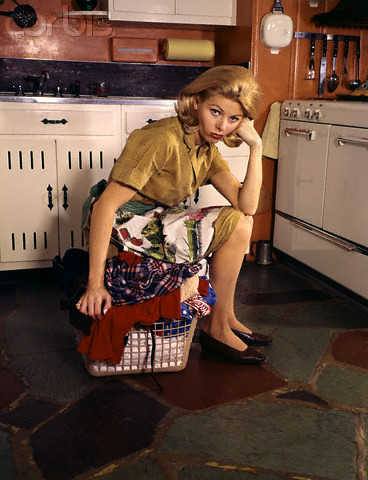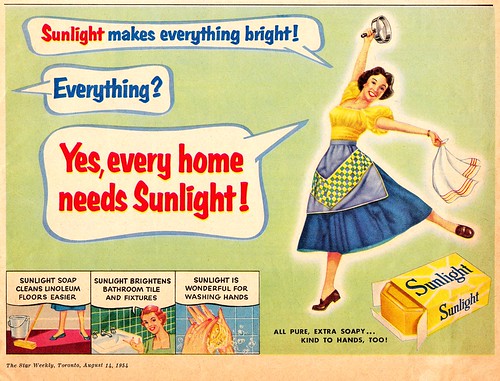 It's been a while since I've read any nonfiction, and Gail Collins' When Everything Changed: The Amazing Journey of American Women from 1960 to the Present has been sitting on my shelf for months. Finally, its call was just too loud to ignore, so I picked it up and dove right in. However, fifty years of revolutionary history is just too big on which to write one, single 300-500 word post, so my review of this work is going to be split up into sections of notes, just as it is in the book and just as I've actually been taking them (I don't think that has happened since college!).
It's been a while since I've read any nonfiction, and Gail Collins' When Everything Changed: The Amazing Journey of American Women from 1960 to the Present has been sitting on my shelf for months. Finally, its call was just too loud to ignore, so I picked it up and dove right in. However, fifty years of revolutionary history is just too big on which to write one, single 300-500 word post, so my review of this work is going to be split up into sections of notes, just as it is in the book and just as I've actually been taking them (I don't think that has happened since college!).Part One of Collins' research is titled "1960," and it sets the stage of the women's movement. Through anecdotes, statistics, and first-hand quotes, Collins puts the reader in 1960 and attempts to paint a thorough picture of just what day-to-day life was like for most women. A lot of the facts confirm the stereotypes that we now believe, fifty years later, but Collins takes it further than that; she puts the facts in historical context and explores why things were the way they were.
The image most of us have as a post-war woman is that of a housewife—the woman perpetually wearing a dress, entranced by new home appliances, and playing a supporting role to the husband on TV shows like Leave it to Beaver and Father Knows Best. Today, can you imagine a world in which:
- Women accounted for only 6% of American doctors, 3% of lawyers, and less than 1% of engineers?
- Wives' names were not even included on a house deed and a woman could not lease an apartment unless it was co-signed by a man?
- Women were banned from certain executive flights, bars, golf courses, and lunch counters because it was believed "men needed faster service than women because they have important business to do?"
- A man made twice as much at the same job as a woman because men "had families to support?"
- (and the clincher...) A woman was thrown out of traffic court for wearing a pair of slacks?
That's pretty much how things were in 1960. Women's assumed place was in the home and, if they did choose to work, it was in a career traditionally occupied by women: teacher/nurse/secretary. But during WWII, if you recall, women joined the workforce while the men were off at war. Rosie the Riveter gave women power! So what happened to that power between 1945 and 1960?
In short, economics. After the war, everyone just wanted everything to return to normal, which included women leaving the workforce and returning home. And because of the huge post-war economic boom and an unprecedented standard of living, many families could survive and prosper with only one source of income. Though just as many women were still working in 1960 as had been during the peak of WWII, it was assumed to be better if the woman could stay at home where her only duties were domestic. Society's standards had not yet seemed to catch up to a reality where women worked outside the home, and most young women, despite having working mothers, assumed they would still be stay-at-home.
 The opening line of chapter two states, "The previous chapter made American women circa 1960 sound very badly treated. But at the time, most of them would not have seen things that way." Its much easier to put yourself in another's position retrospectively, but you have to understand that viewpoints were very different while it was happening; I'm sure many women never considered anything wrong with their way of life. And this is where Collins' research fascinates me. She traces the changing mentality of both women and society as a whole as the nation prepared for a sudden explosion of women's liberation. Why did women suddenly fight for equality and rebel against tradition? Collins slowly dissects the mentality of all sorts of women—urban, suburban, rural, white, black, educated, uneducated, middle-class, lower-class. We see through the examples of individuals how women were educated side-by-side the men in university, but then filtered into gender-appropriate careers and expected to quit once they walked down the aisle. But as Betty Frieden posed in her famous discourse The Feminine Mystique, once the kids had flown the nest, what was left for the mother to do?
The opening line of chapter two states, "The previous chapter made American women circa 1960 sound very badly treated. But at the time, most of them would not have seen things that way." Its much easier to put yourself in another's position retrospectively, but you have to understand that viewpoints were very different while it was happening; I'm sure many women never considered anything wrong with their way of life. And this is where Collins' research fascinates me. She traces the changing mentality of both women and society as a whole as the nation prepared for a sudden explosion of women's liberation. Why did women suddenly fight for equality and rebel against tradition? Collins slowly dissects the mentality of all sorts of women—urban, suburban, rural, white, black, educated, uneducated, middle-class, lower-class. We see through the examples of individuals how women were educated side-by-side the men in university, but then filtered into gender-appropriate careers and expected to quit once they walked down the aisle. But as Betty Frieden posed in her famous discourse The Feminine Mystique, once the kids had flown the nest, what was left for the mother to do?I love the style of this book—short sections within each chapter that focus on one anecdote or piece of evidence. It breaks up what could otherwise be a very heavy, boring narrative full of facts and figures (and it's perfect for public transportation reading!). It's inspiring me to Google search all the people and places that Collins briefly mentions for more information. I am urging my mom to read this and discuss with me, since she was a young woman in the 1960s—the key generation affected by the women's liberation movement; I think her first-hand account would be fascinating.
I promise (maybe) that my commentary on Part Two won't be such a history lesson, but this background was just fascinating to me. It's particularly interesting to hear the everyday stories and understand how several factors and a general feeling of discontent quickly led to such a poignant revolution.
Just a heads up, a review copy was provided to me by the publisher.


8 comments:
Those images you included here are fabulous! I have Collins' "prequel" to this book- America's Women- that I haven't yet read, but I am really excited to read it! And if you liked this one so much, I think I am going to like that one as well.
This sounds like a great read. It's amazing how much things have changed in the past fifty years. My mother was in her 20s during the 60s, and I know she faced things like not going to university because she was a woman (her dad sent her to finishing school instead!). It always bothered her, and I think that's why she always pushed me toward university (she used to tell me, that's when my life would really begin - and she was right).
I just picked this up from the library last week, so I'm glad to see that you liked this! Looking forward to part 2.
i love books that offer insight and history along with a narrative! your review, this segment anyway, is so thorough and thought-provoking. i can't abide by that whole beaver clever scene! i'm eager to take a peek at this book and am looking forward to the next part of the review--replete with the history facts!!
I graduated high school in 1965 and at my daughter's suggestion, started reading this book. I can tell you the facts and insights are "dead on". While in college (which I didn't finish), girls lived in female dorms, checked in and out when leaving the dorm over the watchful eye of a dorm mother, and had to wear raincoats over gym shorts while walking across campus to PE class. It's very interesting to look back and acknowledge what a double standard there was then, and how acceptable it was. And to understand that the culture was absolutely to put women on pedestals while holding them back in so many ways. Thankfully not all women were able to be "put in their place" and we have benefitted (mostly) from that tremendously. Despite the way things were, it was a wonderful time to grow up. I look forward to reading and remembering more about how things changed, and to reading Kari's insights from a 20-something's perspective.
OOooohhhhhhh this sounds fascinating! I keep seeing this book and wanting to pick it up, but haven't yet. Eventually!
Yay, Mom! You blog commented! I think it's interesting how you acknowledge the double standard and mentioned that Nanny and Granddaddy weren't too supportive of you going to college...yet you were never a part of that housewife culture--you've always been a women in the workforce. I can't wait to keep discussing with you.
Belle - That's a great story to share! My mom just told me a similar one about her parents' opinions about college. (see above!)
What a wonderful blog.
Kelly Bookend Diaries
http://bookenddiaries.blogspot.com
Post a Comment